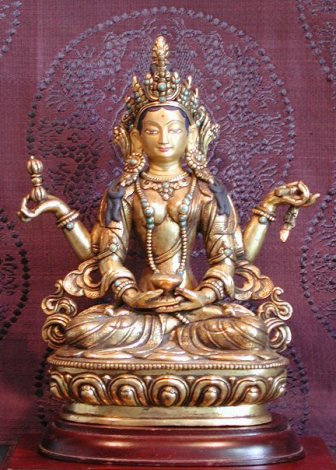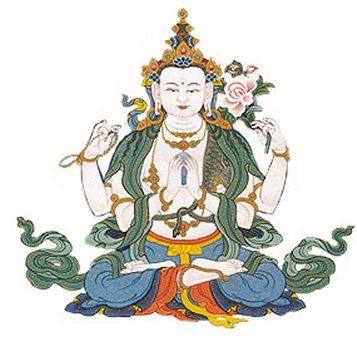The Heart Sutra:The Prajnaparamita Hridaya Sutra
[from Sanskrit "The Heart of Perfect Wisdom Scripture"]

Prajnaparamita
In Himalayan iconography she personifies the whole collection of prajnaparamita sutras, including the Heart Sutra. She is sometimes known under the title, The Mother of All the Buddhas.
Statue made in Nepal by Siddhi Raj, a twentieth century Tibetan artist who practices in the Vajrayana tradition of Buddhism.
The Heart Sutra
Thus have I heard. Once the Blessed One was dwelling in Rajagriha at Vulture Peak mountain, together with a great gathering of the sangha of monks and a great gathering of the sangha of bodhisattvas. At that time the Blessed One entered the samadhi that expresses the dharma called "profound illumination," and at the same time noble Avalokiteshvara, the bodhisattva mahasattva, while practicing the profound prajnaparamita, saw in this way: he saw the five skandhas to be empty of nature.
Then, through the power of the Buddha, venerable Shariputra said to noble Avalokiteshvara, the bodhisattva mahasattva, "How should a son or daughter of noble family train, who wishes to practice the profound prajnaparamita?"
Addressed in this way, noble Avalokiteshvara, the bodhisattva mahasattva, said to venerable Shariputra, "O Shariputra, a son or daughter of noble family who wishes to practice the profound prajnaparamita should see in this way: seeing the five skandhas to be empty of nature. Form is emptiness; emptiness also is form.
Emptiness is no other than form; form is no other than emptiness. In the same way, feeling, perception, formation, and consciousness are emptiness. Thus, Shariputra, all dharmas are emptiness. There are no characteristics. There is no birth and no cessation. There is no impurity and no purity. There is no decrease and no increase. Therefore, Shariputra, in emptiness, there is no form, no feeling, no perception, no formation, no consciousness; no eye, no ear, no nose, no tongue, no body, no mind; no appearance, no sound, no smell, no taste, no touch, no dharmas, no eye dhatu up to no mind dhatu, no dhatu of dharmas, no mind consciousness dhatu; no ignorance, no end of ignorance up to no old age and death, no end of old age and death; no suffering, no origin of suffering, no cessation of suffering, no path, no wisdom, no attainment, and no non-attainment. Therefore, Shariputra, since the bodhisattvas have no attainment, they abide by means of prajnaparamita.
Since there is no obscuration of mind, there is no fear. They transcend falsity and attain complete nirvana. All the buddhas of the three times, by means of prajnaparamita, fully awaken to unsurpassable, true, complete enlightenment. Therefore, the great mantra of prajnaparamita, the mantra of great insight, the unsurpassed mantra, the unequaled mantra, the mantra that calms all suffering, should be known as truth, since there is no deception. The prajnaparamita mantra is said in this way:
OM GATE GATE PARAGATE PARASAMGATE BODHI SVAHA
Thus, Shariputra, the bodhisattva mahasattva should train in the profound prajnaparamita.
Then the Blessed One arose from that samadhi and praised noble Avalokiteshvara, the bodhisattva mahasattva, saying, "Good, good, O son of noble family; thus it is, O son of noble family, thus it is. One should practice the profound prajnaparamita just as you have taught and all the tathagatas will rejoice."
When the Blessed One had said this, venerable Shariputra and noble Avalokiteshvara, the bodhisattva mahasattva, that whole assembly and the world with its gods, humans, asuras, and gandharvas rejoiced and praised the words of the Blessed One.
(This is one translation of the mantra given in Sanskrit above: "Gone, gone, gone beyond, gone altogether beyond: Honor to the Awakened One!")
Lotsawa Bhikshu Rinchen De translated this text into Tibetan with the Indian pandita Vimalamitra. It was edited by the great editor-lotsawas Gelong Namkha and others. This Tibetan text was copied from the fresco in Gegye Chemaling at the glorious Samye vihara. It has been translated into English by the Nalanda Translation Committee, with reference to several Sanskrit editions.
Heart Sutra Home Page: http://cres.anu.edu.au/~mccomas/heartsutra/index.html
This scripture has always been held in the greatest veneration in Mahayana countries. In China and Japan there are at least twenty-eight different recensions of this sacred bible of the Buddhist schools. The Prajnaparamita-Sutra is regarded as the holy mother that feeds the bodhisattva with the amrita (nectar) of prajna (transcendental wisdom), and guides him to paramita (the other shore). It is the "utmost great perfection" which gives full enlightenment to the bodhisattva after he has successfully completed the other five paramitas: dana (charity), sila (morality), ksanti (patience, forbearance), virya (energy), and dhyana (concentration).
Buddhist Links:
Translations of and commentaries upon the Heart Sutra
http://www.theosophy-nw.org/theosnw/world/asia/as-heart.htm /
http://www.geocities.com/Athens/Parthenon/7534/heart.html
Buddhist arts
http://www.taraco.com/home.html
Himalayan Arts: http://www.himalayanart.org/welcome.cfm
Guide to Tibetan Art, Theatre & Music: http://kaladarshan.arts.ohio-state.edu/anu/tib-art.html#west
Other Buddhist Sites:
http://members.tripod.com/~Lhamo/9deity.htm Female Buddhas and Bodhisattvas
http://home.att.net/~edwardchang/home.htm Great resource for wide range of Buddhist sutras
http://www.bpf.org Buddhist Peace Fellowship, and Turning Wheel, a journal of social justice from a Buddhist perspective
http://www.ciolek.com/WWWVL-TibetanStudies.html The Internet Guide to Tibetan Studies
Recommended Reading: Buddhist Wisdom Books: The Diamond and the Heart Sutra, Edward Conze, London: Unwin, 1988.

Chenrezig
An iconographic variation of Avalokiteshavara, the Tibetan meditation deity of compassion